Related Research Articles
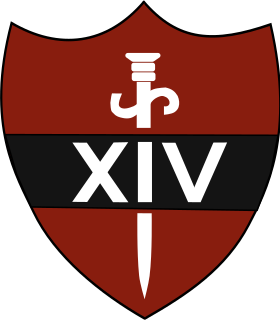
The British Fourteenth Army was a multi-national force comprising units from Commonwealth countries during the Second World War. As well as British Army units, many of its units were from the Indian Army and there were also significant contributions from British Army's West and East African divisions. It was often referred to as the "Forgotten Army" because its operations in the Burma Campaign were overlooked by the contemporary press, and remained more obscure than those of the corresponding formations in Europe for long after the war. For most of the Army's existence, it was commanded by Lieutenant-General William Slim.

The South-East Asian Theatre of World War II consisted of the campaigns of the Pacific War in Burma, India, Thailand, Indonesia, the Philippines, Indochina, Malaya and Singapore between 1941 to 1945.

The British Indian Army, commonly referred to as the Indian Army, was the main military of the British Indian Empire before its decommissioning in 1947. It was responsible for the defence of the British Indian Empire, including the princely states, which could also have their own armies. The Indian Army was an important part of the British Empire's forces, both in India and abroad, particularly during the First World War and the Second World War.
The Ceylon Defence Force (CDF) was established in 1910 by the Ceylonese legislation Ceylon Defence Force Ordinance, which reformed the Ceylon Volunteer Force (CVF) that existed previously as the military reserve in the British Crown colony of Ceylon. At the time of forming it was only a reserve force but soon developed into a regular force responsible for the defence of Ceylon. The CDF was under the command of the General Officer Commanding, Ceylon of the British Army in Ceylon if mobilised. However mobilisation could be carried out only under orders from the Governor.

Home guard is a title given to various military organizations at various times, with the implication of an emergency or reserve force raised for local defense.

After the outbreak of the Second World War, in the British Crown Colony of Ceylon, the government of Sir Don Baron Jayatilaka assured the British king and his majesty's government of its continued support.
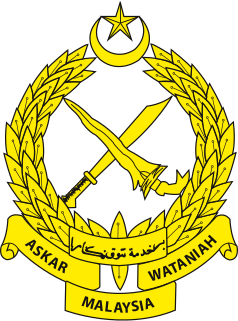
The Rejimen Askar Wataniah is the military reserve force of the Malaysian Army.

The Sri Lanka Army is the oldest and largest of the Sri Lanka Armed Forces. Established as the Ceylon Army in 1949, it was renamed when Sri Lanka became a republic in 1972. In 2010, the Army had approximately 200,000 regular personnel, between 20,000 and 40,000 reserve (volunteer) personnel and 18,000 National Guardsmen and comprises 13 divisions, one air-mobile brigade, one commando brigade, one special forces brigade, one independent armored brigade, three mechanized infantry brigades and over 40 infantry brigades. From the 1980s to 2009, the army was engaged in the Sri Lankan Civil War.

The Sri Lankan Armed Forces award medals and their associated ribbon bars in recognition of various levels of service, personal accomplishments and commemorative events while a regular- or volunteer serviceperson is a member of the Sri Lanka Army, Sri Lanka Navy and the Sri Lanka Air Force. Together with military badges, such awards are a means to outwardly display the highlights of a serviceperson's career.
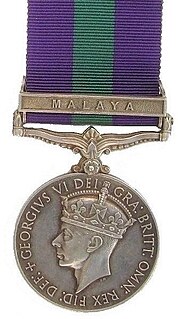
The General Service Medal was instituted to recognise service in minor Army and Royal Air Force operations for which no separate medal was intended. Local forces, including police, qualified for many of the clasps, as could units of the Indian Army prior to 1947.
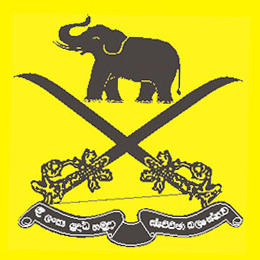
The Sri Lanka Army Volunteer Force (SLAVF) is the active-duty volunteer reserve force of the Sri Lanka Army. The SLAVF is separate from the Regular Force which consists of personal who are professional soldiers and its Regular Reserve, which comprises personal who have a mobilization obligation following their service in the regular army. The SLAVF consists of the volunteer force and the volunteer reserve; administration and recruitment of reserve personal is carried out by the Volunteer Force Headquarters in Shalawa, Kosgama which is headed by the Commandant of the Volunteer Force. It has a current strength of about 55,000 personnel. The SLAVF was known as the Ceylon Volunteer Force from 1949 to 1972 and the Sri Lanka Volunteer Force from 1972 to 1985.
The Ceylon Planters Rifle Corps was a regiment of the Ceylon Defence Force, which existed between 1900 and 1949. It was a volunteer (reserve) regiment based in Kandy, made up of only Europeans that were tea and rubber planters of the hills of Sri Lanka. The regiment deployed personnel to fight in the Second Boer War, the First, and Second World Wars.
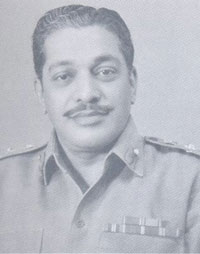
General Deshamanya Don Sepala Attygalle, LVO was a Sri Lankan senior army officer, civil servant and diplomat. The longest serving Commander of the Sri Lankan Army (1967–1977), he went on to serve as the Permanent secretary to the Ministry of Defence and Sri Lankan High Commissioner to the United Kingdom.
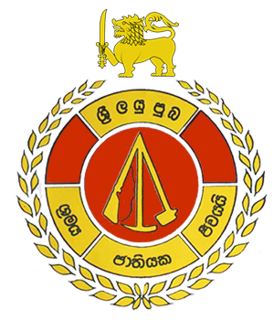
The Sri Lanka Army Pioneer Corps (SLAPC) is a (reserve) regiment of the Sri Lanka Army. Established as manpower reserve to be utilized in times of strikes and union action to maintain the functionality of essential services and other state functions, other such units that existed then and has since been disband include the Post and Telegraph Signals (PTS) and the Ceylon Railway Engineer Corps (CREC). With the escalation of the Sri Lankan Civil War the regiment has taken up combat duties.
General Tissa Indraka Weeratunga, VSV was a Sri Lankan senior army officer. He was a former Commander of the Sri Lankan Army and first General Officer Commanding (GOC) of the Joint Operations Headquarters (JOH), he was later Sri Lanka's High Commissioner to Canada.

The Sri Lanka Armed Forces is the overall unified military of the Democratic Socialist Republic of Sri Lanka encompassing the Sri Lanka Army, the Sri Lanka Navy, and the Sri Lanka Air Force; they are governed by the Ministry of Defence (MoD). The three services have around 346,700 active personnel; conscription has never been imposed in Sri Lanka. The Sri Lanka Coast Guard is also under the purview of the Ministry of Defence and its members are all from the Sri Lanka Navy.

Ceylon Post and Telegraph Signals Corps was a departmental corps of the Ceylon Defense Force from 1943 to 1945 and of the Ceylon Volunteer Force 1955 to 1956. It was formed in February 1946, from the Post and Telegraph Signals Unit of the Ceylon Engineers Corps. It was disbanded following the disbanding of the Ceylon Defence Force on 11 April 1949 and formation of the Ceylon Army by Army Act No. 17 of 1949 which revoked the Ceylon Defence Force Ordinance of 1910. The corps was reformed in 1955 with staff from the Department of Post and Ceylon Telegraph Department. The government hoped to minimized the effects to the Post and Telegraph services in the event of trade union action by mobilizing the personnel attached to this unit. However it was disbanded in 1956 when the leftist S.W.R.D. Bandaranaike became prime minister.
Brigadier M. H. Gunaratne, VSV, psc, SLAC was a Sri Lankan military officer, former Commander Security Forces Headquarters - East, Commander, Task Force I and Task Force III and Commandant, Army Training Centre
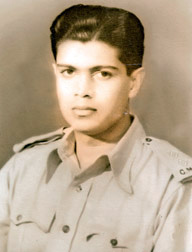
Lieutenant Colonel Dr. Anthony St. Clare Rex de Costa, MBE, CAVF was a renowned Sri Lankan medical doctor and soldier. He was the commanding officer of the Ruhunu Regiment, a doctor in the Ceylon Defence Force during World War II and a vice president of the World Veterans Federation. He was assassinated by the JVP during the 1971 Insurrection.
The National Guard of Pakistan is a reserve military force and the component of the Pakistan Army that is designed to act as a "second line of defense" in Pakistan. together with the Pakistan Army Reserve, the Frontier Corps and the Pakistan Rangers.
References
- ↑ "THE PIONEER FORCE: AN ACCOUNT OF A. PARAMILITARY CORPS OF GOVERNMENT SERVANTS WHO SERVED IN. CEYLON AND MALAYA". um.edu.my. Retrieved 4 April 2022.
- ↑ "TERMS OF AWARD OF THE NAVAL GENERAL SERVICE MEDAL AND THE GENERAL SERVICE MEDAL (ARMY AND ROYAL AIR FORCE)" (PDF). defence.gov.au. Retrieved 3 April 2022.